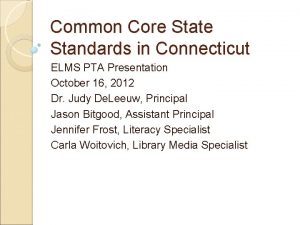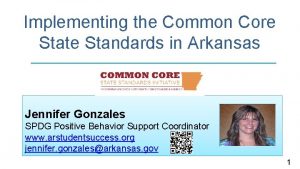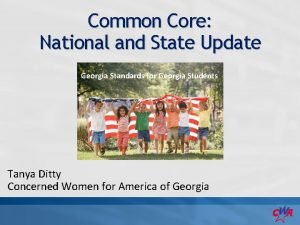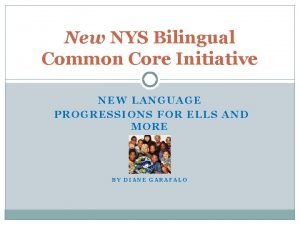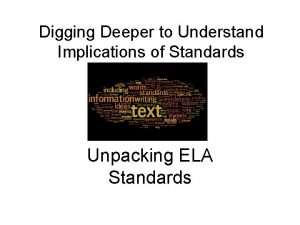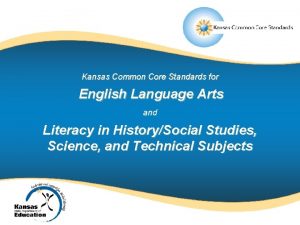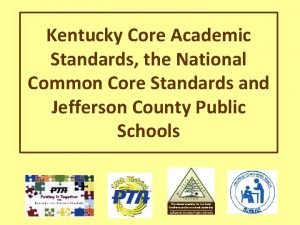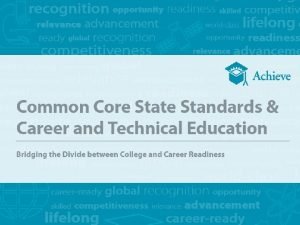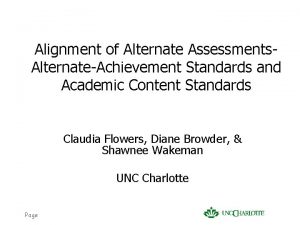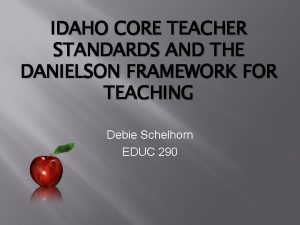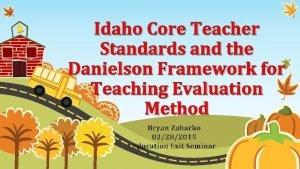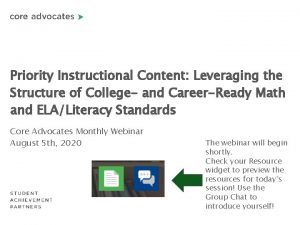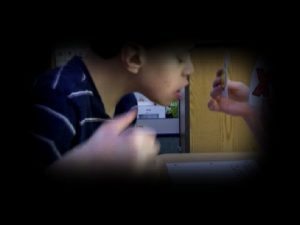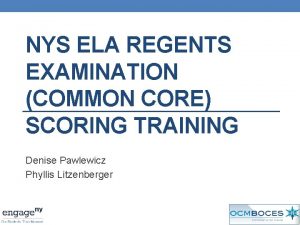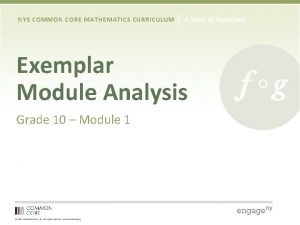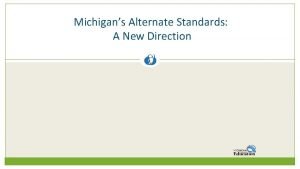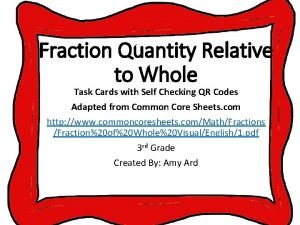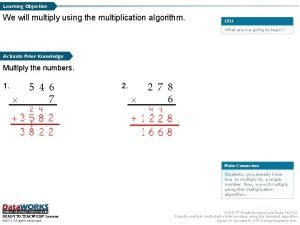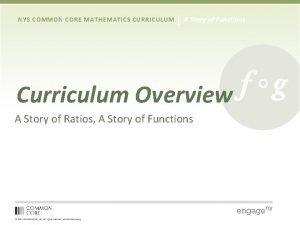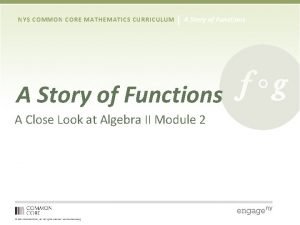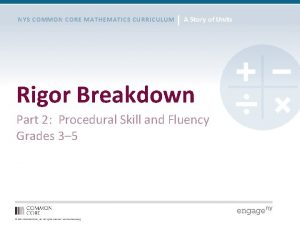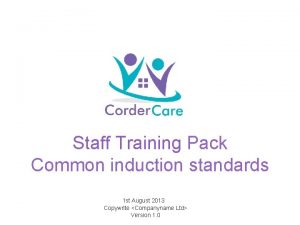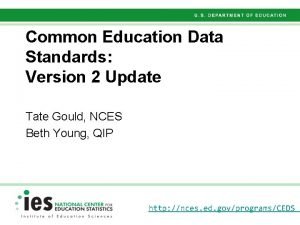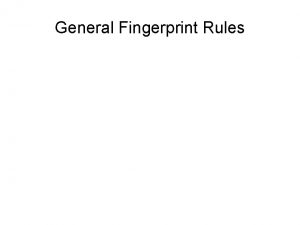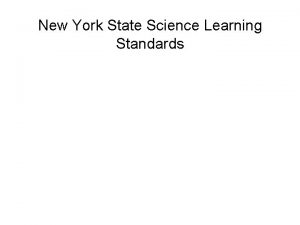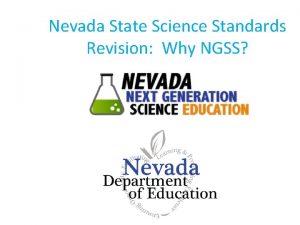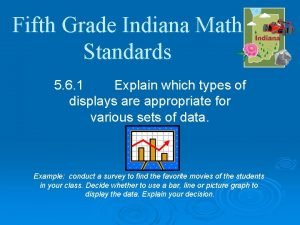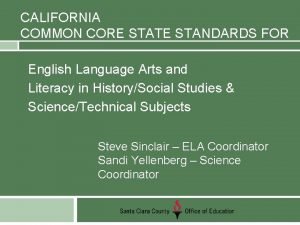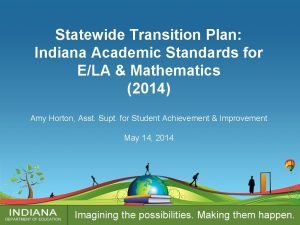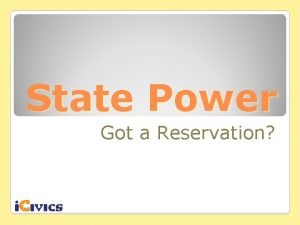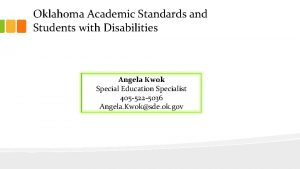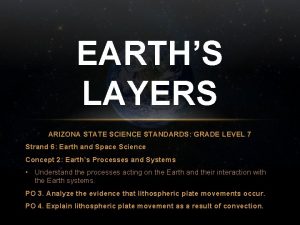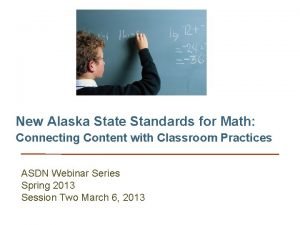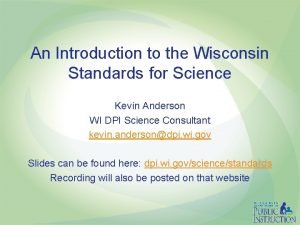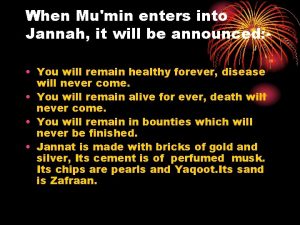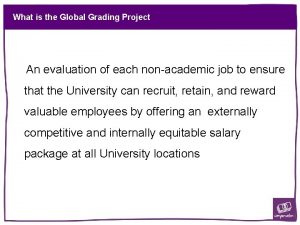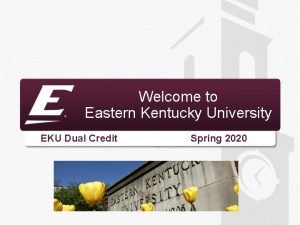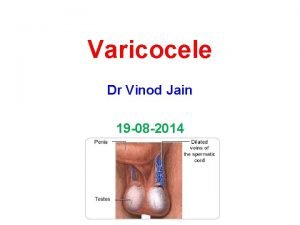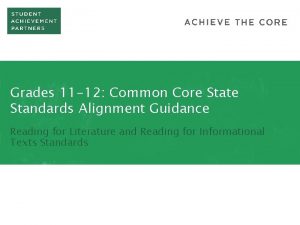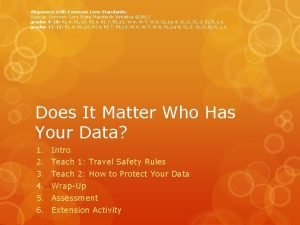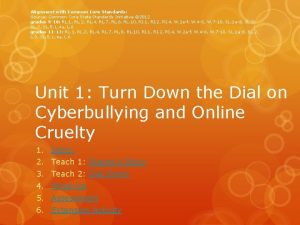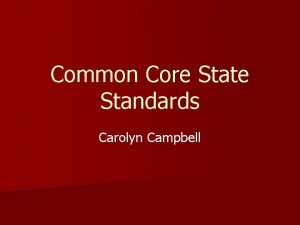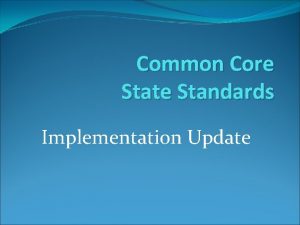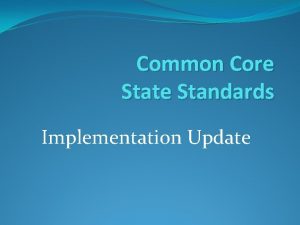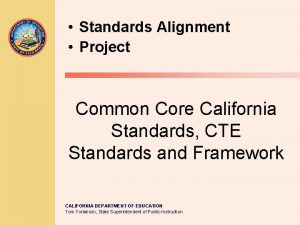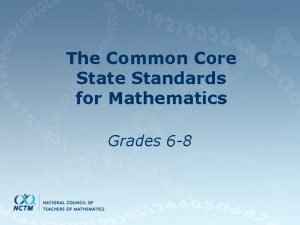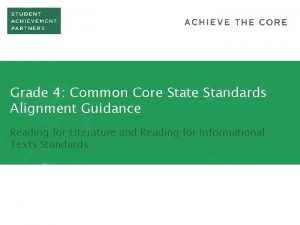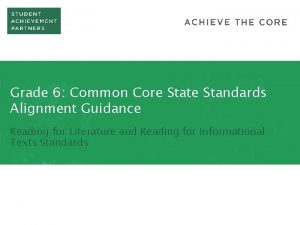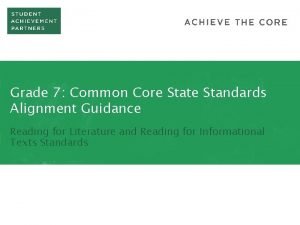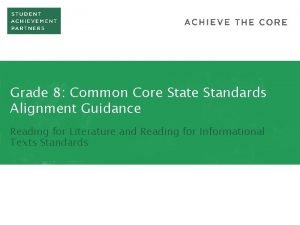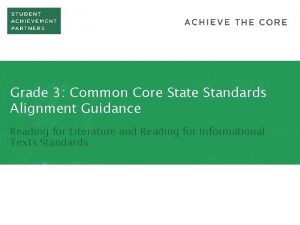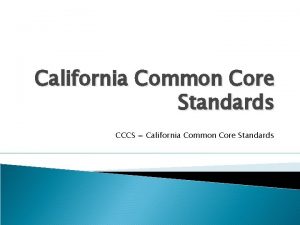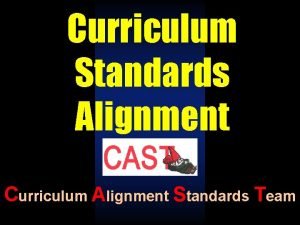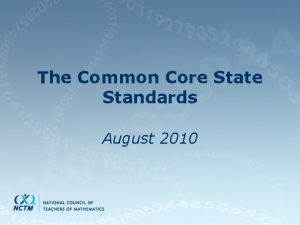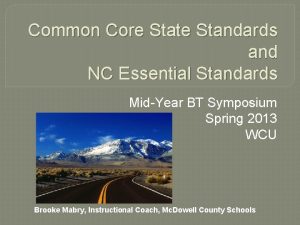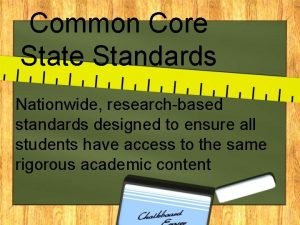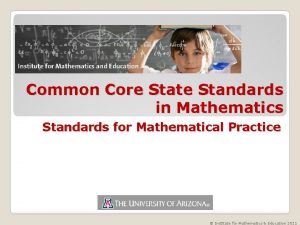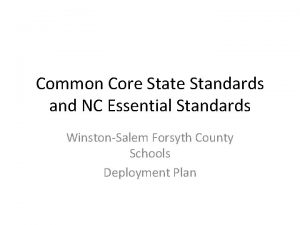Grades 9 10 Common Core State Standards Alignment
































































- Slides: 64

Grades 9 -10: Common Core State Standards Alignment Guidance Reading for Literature and Reading for Informational Texts Standards

Session Objective The purpose of these materials is to help develop understanding of the expectations of high-quality summative assessment items. The concepts shown throughout these modules can be useful for classroom questioning and assessment, but the items themselves may need to be slightly modified. PAGE 2

Reading Standards for Literature

Links to Associated Literary Texts The literary sample items are written to the texts linked below. To better understand the points made in each item, you should familiarize yourself with each text. • Excerpt from Julius Caesar, Act III, Scene ii by William Shakespeare • “The Walrus and the Carpenter” by Lewis Carroll and “The Walrus and the Carpenter Head Back” by J. T. Holden PAGE 4

Diving into the Specific Grade-Level Standards Remember that Standards 1 and 10 are bookends requiring: • all passages to be appropriately complex • all items to be answered using textual evidence Items should never be aligned to Standard 1 only. Instead, items should be aligned to Standard 1 and at least one other standard. PAGE 5

CCSS. ELA-Literacy. RL. 9 -10. 2 Determine a theme or central idea of a text and analyze in detail its development over the course of the text, including how it emerges and is shaped and refined by specific details; provide an objective summary of the text. PAGE 6

In “The Walrus and the Carpenter, ” what central idea emerges from stanzas 16– 17? A. The Carpenter is disappointed by the Oysters’ failure to join the conversation. B. The Walrus feels somewhat conflicted over tricking the Oysters. C. The Oysters trust Walrus and Carpenter and follow their orders exactly. D. The Oysters are too tired to be aware of the danger posed by the Walrus and the Carpenter. Associated Text: “The Walrus and the Carpenter” by Lewis Carroll PAGE 7

The following question has two parts. Answer Part A and then answer Part B. Part A: In “The Walrus and the Carpenter, ” what central idea emerges from stanzas 16– 17? A. The Carpenter is disappointed by the Oysters’ failure to join the conversation. B. The Walrus feels somewhat conflicted over tricking the Oysters. C. The Oysters trust Walrus and Carpenter and follow their orders exactly. D. The Oysters are too tired to be aware of the danger posed by the Walrus and the Carpenter. Part B: In the stanzas mentioned above, circle two consecutive lines that show the correct answer to Part A. Associated Text: “The Walrus and the Carpenter” by Lewis Carroll PAGE 8

Drag the details from the “Events” list to the “Summary box, ” in the correct order of the text, to create a complete summary of Julius Caesar, Act III, scene ii. You will use all of the details once. Summary 1. 2. 3. 4. 5. Events In reading Caesar’s will, Antony notes that Caesar left his money and land to the people of Rome. Antony leaves the stage to join the crowd. Antony says that Caesar rejected the role of king three times. The citizens decide to rebel against those who killed Caesar. Antony calls Brutus an honourable man. Associated Text: Julius Caesar, Act III, scene ii by William Shakespeare PAGE 9

Which sentence provides the best summary of Julius Caesar, Act III, scene ii? A. Despite his initial fears, Antony manages to gain the sympathy of the crowd at Caesar’s funeral. B. Through direct insults of Brutus and his friends, Antony convinces the crowd to avenge Caesar’s death. C. Despite believing that he bears some of the burden of Caesar’s death, Antony convinces the crowd of his innocence. D. Through careful wording, Antony manages to turn the crowd against those who murdered Caesar. Associated Text: Julius Caesar, Act III, scene ii by William Shakespeare PAGE 10

CCSS. ELA-Literacy. RL. 9 -10. 3 Analyze how complex characters (e. g. , those with multiple or conflicting motivations) develop over the course of a text, interact with other characters, and advance the plot or develop theme. PAGE 11

In “The Walrus and the Carpenter Head Back, ” which statement best describes how the Oysters feel when they see the Walrus and the Carpenter stuck in the sand? A. They are pleased their friends are in trouble. B. They are happy to see their old friends. C. They are excited that they may get revenge. D. They are curious to see what will happen next. Associated Text: “The Walrus and the Carpenter Head Back” by J. T. Holden PAGE 12

The following question has two parts. Answer Part A and then answer Part B. Part A: In Text 2, which statement best describes how the Oysters feel when they see the Walrus and the Carpenter stuck in the sand? A. They are pleased their friends in trouble. B. They are happy to see their old friends. C. They are excited that they may get revenge. D. They are curious to see what will happen next. Part B: Which pair of lines from Text 2 best support the correct answer to Part A? A. “Whilst from the frothy breaking waves They came now, hand-in-hand. ” B. “Four dozen Oysters followed fast, And yet four hundred more; ” C. “And thick and quick, their bodies slick, They gathered on the shore—” D. “All circling round and closing in, More eager than before. ” Associated Text: “The Walrus and the Carpenter Head Back” by J. T. Holden PAGE 13

CCSS. ELA-Literacy. RL. 9 -10. 4 Determine the meaning of words and phrases as they are used in the text, including figurative and connotative meanings; analyze the cumulative impact of specific word choices on meaning and tone (e. g. , how the language evokes a sense of time and place; how it sets a formal or informal tone). PAGE 14

Read these lines from stanza 1 of “The Walrus and the Carpenter. ” He did his very best to make The billows smooth and bright -What does billows mean as it is used in the sentence? A. Shadows B. Clouds C. Rays D. Waves The remaining text from stanza 1 has been provided below for reference: The sun was shining on the sea, Shining with all his might: He did his very best to make The billows smooth and bright— And this was odd, because it was The middle of the night Associated Text: “The Walrus and the Carpenter” by Lewis Carroll PAGE 15

The following question has two parts. Answer Part A and then answer Part B. Part A: What does lament mean as it is used in stanza 17 of “The Walrus and the Carpenter Head Back”? A. Fear B. Mourn C. Worry D. Suffer Part B: Which word from stanza 17 of “The Walrus and the Carpenter Head Back” best helps the reader determine the meaning of lament? A. “Weep” B. “Boiling” C. “Cabbages” D. “Ferment” Associated Text: “The Walrus and the Carpenter Head Back” by J. T. Holden PAGE 16

What tone is set by Carroll’s choice of words in “The Walrus and the Carpenter”? A. Humorous B. Cheerful C. Sympathetic D. Thoughtful Associated Text: “The Walrus and the Carpenter” by Lewis Carroll PAGE 17

In “The Walrus and the Carpenter, ” what is one effect of Carroll’s word choice on the overall tone of the poem? A. His deliberate description of exaggerated emotion creates a humorous tone. B. His thoughtful description of each character creates a cheerful tone. C. His purposeful use of rhyme and meter creates a sympathetic tone. D. His careful use of dialogue creates a thoughtful tone. Associated Text: “The Walrus and the Carpenter” by Lewis Carroll PAGE 18

CCSS. ELA-Literacy. RL. 9 -10. 5 Analyze how an author’s choices concerning how to structure a text, order events within it (e. g. , parallel plots), and manipulate time (e. g. , pacing, flashbacks) create such effects as mystery, tension, or surprise. PAGE 19

What effect is created in Lewis Carroll’s “The Walrus and the Carpenter”? A. Mystery B. Anxiety C. Surprise D. Fear Associated Text: “The Walrus and the Carpenter” by Lewis Carroll PAGE 20

The following question has two parts. Answer Part A and then answer Part B. Part A: In “The Walrus and the Carpenter, ” how does Carroll develop a pattern of surprise? A. He uses dialogue to reveal confusing and ridiculous situations. B. He provides detailed explanations of things that are not important. C. He gives clues that hint at what will happen to each character. D. He provides hints that show things are not as predictable as they first seem. Part B: Which TWO stanzas from Text 1 best support the correct answer to Part A? A. Stanza 1 B. Stanza 3 C. Stanza 5 D. Stanza 8 E. Stanza 11 F. Stanza 15 Associated Text: “The Walrus and the Carpenter” by Lewis Carroll PAGE 21

CCSS. ELA-Literacy. RL. 9 -10. 6 Analyze a particular point of view or cultural experience reflected in a work of literature from outside the United States, drawing on a wide reading of world literature. PAGE 22

Which sentence best describes Marc Antony’s perspective about Brutus and the other conspirators? A. Antony dislikes what they did but understands why they felt they needed to take action. B. Antony believes they have created the opportunity for a new future for Romans. C. Antony thinks that they betrayed Rome by killing Caesar. D. Antony hopes that they will be satisfied now that Caesar is dead. Associated Text: Julius Caesar, Act III, scene ii by William Shakespeare PAGE 23

The following question has two parts. Answer Part A and then answer Part B. Part A: Anthony’s speech is most meant to appeal to which aspect of Roman culture? A. Just treatment of others based on their actions B. Ambition to increase the size of the empire C. Greed for material possessions D. Forgiveness for mistakes Part B: Which excerpt from the play best supports the correct answer to Part A? A. “The noble Brutus Hath told you Caesar was ambitious: If it were so, it was a grievous fault, And grievously hath Caesar answer'd it. ” B. “He hath brought many captives home to Rome Whose ransoms did the general coffers fill: Did this in Caesar seem ambitious? ” C. “You all did love him once, not without cause: What cause withholds you then, to mourn for him? O judgment! thou art fled to brutish beasts, And men have lost their reason. ” D “I come not, friends, to steal away your hearts: I am no orator, as Brutus is; But, as you know me all, a plain blunt man, That love my friend” Associated Text: Julius Caesar, Act III, scene ii by William Shakespeare PAGE 24

CCSS. ELA-Literacy. RL. 9 -10. 7 Analyze the representation of a subject or a key scene in two different artistic mediums, including what is emphasized or absent in each treatment (e. g. , Auden’s “Musée des Beaux Arts” and Breughel’s Landscape with the Fall of Icarus). PAGE 25

What would most likely be included in a picture representing the excerpt from Julius Caesar, Act III, scene ii? A. Brutus’s reaction to Antony’s words B. Brutus and his co-conspirators plotting to murder Caesar C. The crowd’s initial reaction to Caesar’s murder D. Antony speaking to a crowd of Roman citizens Associated Text: Julius Caesar, Act III, scene ii by William Shakespeare PAGE 26

Watch this video of Julius Caesar. http: //www. dailymotion. com/video/xsjkfr_friendsromans-countrymen-lend-me-your-ears_creation What aspect of the scene is more apparent in the video than in the written excerpt? A. The influence of Antony’s speech on the crowd of citizens B. How Caesar was killed and who was responsible C. The depth of Antony’s anguish as he delivers his speech D. The various accomplishments of Caesar as the ruler of Rome Associated Text: Julius Caesar, Act III, scene ii by William Shakespeare; Film excerpt of Julius Caesar, 1953. PAGE 27

CCSS. ELA-Literacy. RL. 9 -10. 8 Standard 8 does not apply to literature PAGE 28

CCSS. ELA-Literacy. RL. 9 -10. 9 Analyze how an author draws on and transforms source material in a specific work (e. g. , how Shakespeare treats a theme or topic from Ovid or the Bible or how a later author draws on a play by Shakespeare). PAGE 29

Complete the table by dragging each idea from the “Details” box and dropping it under the title of the text it represents. Each detail will be used at least once, and one detail will be used twice. “The Walrus and the Carpenter” by Lewis Carroll “The Walrus and the Carpenter Head Back” by J. T. Holden Details The oysters do the eating Set at night The Walrus weeps Set during the day The Walrus and the Carpenter walk along a beach The oysters are eaten The Carpenter weeps Associated Texts: “The Walrus and the Carpenter” by Lewis Carroll and “The Walrus and the Carpenter Head Back” by J. T. Holden PAGE 30

In “The Walrus and the Carpenter Head Back, ” how does Holden transform the characters from “The Walrus and the Carpenter”? A. In Carroll’s poem the eldest Oyster is a passive observer, while in Holden’s poem, he is an active leader. B. In Carroll’s poem the Moon silently seethes, while in Holden’s poem, she directly tells the Sun how she feels. C. In Carroll’s poem the Walrus and the Carpenter do not feel regret for their actions, while in Holden’s poem, they do. D. In Carroll’s poem, the reader must guess at why the characters take certain actions, while in Holden’s poem their motives are explained. Associated Texts: “The Walrus and the Carpenter” by Lewis Carroll and “The Walrus and the Carpenter Head Back” by J. T. Holden PAGE 31

Bottom Line for Reading for Literature Standards Questions are – based on texts that are of appropriate complexity. They are worthy of students’ attention. (Standard 10) Questions require – students to read closely and think deeply about key ideas and specifics of the texts. They are questions worth answering. – students to use textual evidence to help them formulate their responses. They help prepare students for the demands of careers and college. (Standard 1) PAGE 32

Reading Standards for Informational Text

Diving into the Specific Grade-Level Standards Remember that Standards 1 and 10 are bookends requiring: • all passages to be appropriately complex • all items to be answered using textual evidence PAGE 34

Links to Associated Informational Texts The informational sample items are written to the texts linked below. To better understand the points made in each item, you should familiarize yourself with each text. • “Nowhere to Go” by Kathiann M. Kowalski • “A Big Surprise at the Edge of the Solar System” by Dr. Tony Phillips • The Manhattan Project Text Set PAGE 35

CCSS. ELA-Literacy. RI. 9 -10. 2 Determine a central idea of a text and analyze its development over the course of the text, including how it emerges and is shaped and refined by specific details; provide an objective summary of the text. PAGE 36

Which sentence best states a central idea of the section “Sitting and Sitting” in “Nowhere to Go”? A. It will take a tremendous amount of time and money to find an appropriate nuclear waste disposal site. B. Many states are under consideration to become the next nuclear waste disposal site. C. Scientists believe that it is safe to store nuclear waste in the location where it will ultimately be disposed of. D. Storage and disposal are two different issues related to the use of nuclear power in this country. Associated Text: “Nowhere to Go” by Kathiann M. Kowalski PAGE 37

Select three details the author uses to develop the central idea regarding waste disposal sites. A. The description of how states and individuals have objected to proposed sites B. The description of a 2013 court decision regarding the NRC and site reviews C. The quotation from an expert who says anticipating the future is difficult D. The explanation that in-depth study of proposed sites is needed E. The indication that Yucca Mountain is no longer a possible site F. The explanation of how fission continues to add to the growing amount of waste G. The mention of the financial limitations faced by the NRC Associated Text: “Nowhere to Go” by Kathiann M. Kowalski PAGE 38

Which sentence provides the best summary of paragraphs 1 -4 of “A Big Surprise from The Edge of the Solar System”? A. The Voyager probes are important to scientific discovery. B. The Voyager probes recently discovered that the solar system is bubbly. C. The Voyager probes are currently 9 billion miles away from Earth. D. The Voyager probes entered the foam zone in 2007. Associated Text: “A Big Surprise from The Edge of the Solar System” by Dr. Tony Phillips PAGE 39

Complete a summary of the article by writing the ideas from the “Possible Ideas” table in the “Summary” table in an order that builds to produce a complete account. Not all ideas will be used. Summary First Second Third Fourth Possible Ideas Cosmic rays are subatomic particles that travel at nearlight speed. In the 1950’s, the magnetic field of the sun was believed to be in the shape of an arc. Scientists expect to make further discoveries based on the data recorded by the Voyager craft. Scientists believe the foam-like magnetic fields are caused by the spinning of the sun. A new theory of magnetic foam is based on information gathered by the Voyager craft. The border between the Milky Way and the Solar System is known as “the heliosheath. ” Associated Text: “A Big Surprise from The Edge of the Solar System” by Dr. Tony Phillips PAGE 40

CCSS. ELA-Literacy. RI. 9 -10. 3 Analyze how the author unfolds an analysis or series of ideas or events, including the order in which the points are made, how they are introduced and developed, and the connections that are drawn between them. PAGE 41

Which two elements combine to produce nuclear fission? A. radioactive particles and energy B. energy and reactions C. reactions and atoms D. steam and elements Associated Text: “Nowhere to Go” by Kathiann M. Kowalski PAGE 42

Which sentence explains an association between fission and radioactivity in a nuclear reactor? A. Fission starts the chain reaction that makes particles radioactive. B. Fission is dangerous to elements because it causes them to be radioactive. C. The byproducts of fission are highly radioactive and dangerous. D. Uranium is the result of fission and radioactive elements combining. Associated Text: “Nowhere to Go” by Kathiann M. Kowalski PAGE 43

CCSS. ELA-Literacy. RI. 9 -10. 4 Determine the meaning of words and phrases as they are used in a text, including figurative, connotative, and technical meanings; analyze the cumulative impact of specific word choices on meaning and tone (e. g. , how the language of a court opinion differs from that of a newspaper). PAGE 44

What does imminent mean in Paragraph 1 of “Truman Tells Stalin, July 24, 1945”? A. permanent B. subsequent C. unalterable D. Forthcoming Paragraph 1 provided below for reference: Most of the groups and individuals who had considered the subject—from the Scientific Panel to the writers of the Franck Report—believed it necessary to inform the USSR of the imminent success of the Manhattan project. Failure to do so, they believed, would guarantee a post-war atmosphere of suspicion and hostility. Associated Text: “Truman Tells Stalin, July 24, 1945” from Atomic Bomb: Decision by Gene Dannon PAGE 45

Based on the context of “Truman Tells Stalin, July 24, 1945, ” what is the meaning of the word tactic? A. deliberate action B. impulsive decision C. detailed process D. ultimate plan Paragraph 2 provided below for reference: At the Potsdam Conference, however, President Truman chose to tell Stalin only that the U. S. possessed “a new weapon of unusual destructive force. ” Truman’s decision raises an obvious question: Since Stalin would learn of the existence of the atomic bomb the day it was used, if he did not know already, what purpose could be served by Truman’s tactic. Associated Text: “Truman Tells Stalin, July 24, 1945” from Atomic Bomb: Decision by Gene Dannon PAGE 46

CCSS. ELA-Literacy. RI. 9 -10. 5 Analyze in detail how an author's ideas or claims are developed and refined by particular sentences, paragraphs, or larger portions of a text (e. g. , a section or chapter). PAGE 47

The following question has two parts. Answer Part A and then answer Part B. Part A: Which sentence best states Kamps’ claim about radioactive waste? A. Radioactive waste is lethal in large doses. B. Finding a disposal site for radioactive waste is time consuming. C. Radioactive waste can pose a threat for a significant amount of time. D. Finding a safe way to dispose of radioactive waste is dangerous. Part B: Which sentence from the passage best reveals the correct answer to Part A? A. “High-level radioactive waste can present hazards ‘for a million years or more…’” B. “After five years, there’s been enough cooling of the spent fuel that it can be transferred from the spent fuel pools into dry storage…” C. “‘Even though it’s in an arid location, underground there’s a lot of moisture’ at Yucca Mountain, …” D. “Trying to find that repository is like trying to look into a crystal ball…” Associated Text: “Nowhere to Go” by Kathiann M. Kowalski PAGE 48

In paragraph 5, the author quotes Kevin Kamps’ belief that “high levels of radioactive waste present hazards ‘for a million years or more…’” How do the ideas in paragraphs 11 -18 build on this claim? A. Kamps’ quotation indicates that some people are uncomfortable with consequences of using nuclear power, and paragraphs 11 -18 describe how government officials are divided over the issue of disposal. B. Kamps’ quotation suggests that nuclear power is dangerous, and paragraphs 11 -18 provide details about the negative effects that radioactive waste could have on the environment. C. Kamps’ quotation indicates why finding the right disposal site is important, and paragraphs 11 -18 explain the obstacles that have so far prevented the government from finding such a site. D. Kamps’ quotation shows that radioactive waste will have long-term effects on the planet, and paragraphs 11 -18 confirm that such waste will be around much Associated Text: “Nowhere to Go” by Kathiann M. Kowalski PAGE 49

CCSS. ELA-Literacy. RI. 9 -10. 6 Determine an author's point of view or purpose in a text and analyze how an author uses rhetoric to advance that point of view or purpose. PAGE 50

Which sentence states one of the author’s purposes in the article? A. To explain the challenges related to strong radioactive waste B. To describe why scientists disagree about the future of nuclear power C. To show spent fuel is stored in the different states D. To reveal places where nuclear fission is an important source of power Associated Text: “Nowhere to Go” by Kathiann M. Kowalski PAGE 51

The following question has two parts. Answer Part A and then answer Part B. Part A: Which sentence states one of the author’s purposes in the article? A. To explain the challenges related to strong radioactive waste B. To describe why scientists disagree about the future of nuclear power C. To show spent fuel is stored in the different states D. To reveal places where nuclear fission is an important source of power [This item is continued on the next slide. ] PAGE 52

Part B: The author uses several rhetorical strategies to help achieve her purpose. An example of each rhetorical device is presented below. Fill in the blank next to each device with an explanation of how it contributes the purpose. You will not use all ofcontributes the Example of ato rhetorical device Explanation of how the device to the purpose available explanations. Quotes from experts Figurative language Short sentences and familiar language Explanations To simplify complex concepts To explain her own opinions To provide examples of challenging ideas To demonstrate why things matter To provide evidence to support claims To exaggerate details for powerful effect Associated Text: “Nowhere to Go” by Kathiann M. Kowalski PAGE 53

CCSS. ELA-Literacy. RI. 9 -10. 7 Analyze various accounts of a subject told in different mediums (e. g. , a person’s life story in both print and multimedia), determining which details are emphasized in each account. PAGE 54

Which fact about cosmic rays is present in both “A Big Surprise from the Edge of the Solar System” and “Heliosphere Surprise”? A. Cosmic rays move at near-light speed. B. Cosmic rays are accelerated by black holes and supernova explosions. C. Cosmic rays are dangerous particles in the solar system. D. Cosmic rays are subatomic particles. Associated Stimuli: “A Big Surprise from The Edge of the Solar System” by Dr. Tony Phillips and NASA video “Heliosphere Surprise” PAGE 55

In paragraph 9 of the article, the author explains that “Energetic particle sensor readings suggest that the Voyagers are occasionally dipping in and out of the foam—so there might be regions where the old ideas still hold. ” Which image from the video best emphasizes this idea? Associated Stimuli: “A Big Surprise from The Edge of the Solar System” by Dr. Tony Phillips and NASA video “Heliosphere Surprise” PAGE 56

CCSS. ELA-Literacy. RI. 9 -10. 8 Delineate and evaluate the argument and specific claims in a text, assessing whether the reasoning is valid and the evidence is relevant and sufficient; identify false statements and fallacious reasoning. PAGE 57

Write an essay that describes Dr. Tony Phillips’s claim the appearance of the heliosheath in “A Big Surprise at the Edge of the Solar System. ” Explain the evidence Dr. Phillips gives to support the claim. Use details from the text to support your answer. Associated Text: “A Big Surprise from The Edge of the Solar System” by Dr. Tony Phillips PAGE 58

In “A Big Surprise from the Edge of the Solar System, ” Dr. Tony Phillips makes a claim about the appearance of the heliosheath. Write an essay that describes this claim, and evaluates the type of evidence Dr. Phillips uses to support his claim. Is the evidence provided relevant and sufficient to justify the claim? Does Dr. Phillips use evidence in a logical way to develop his argument about the appearance of the heliosheath? Use details from the passage to support your answer. Associated Text: “A Big Surprise from The Edge of the Solar System” by Dr. Tony Phillips PAGE 59

CCSS. ELA-Literacy. RI. 9 -10. 9 Analyze seminal U. S. documents of historical and literary significance (e. g. , Washington’s Farewell Address, the Gettysburg Address, Roosevelt’s Four Freedoms speech, King’s "Letter from Birmingham Jail"), including how they address related themes and concepts. PAGE 60

The article and the video both describe the appearance and function of the heliosheath. Write an essay to explain how watching the video helps add meaning to information from the text. Be sure to include details from both the video and the text in your response. Associated Stimuli: “A Big Surprise from The Edge of the Solar System” by Dr. Tony Phillips and NASA video “Heliosphere Surprise” PAGE 61

Using information synthesized from the different texts, write an analysis of the way Truman broke the news of the Manhattan Project to Stalin. Describe the advantages and disadvantages of Truman’s approach and explain how it may have affected United States Soviet relations. Be sure to support your analysis with evidence from the texts. Associated Texts: The Manhattan Project Text Set PAGE 62

Bottom Line for Reading for Information Standards Questions are – based on texts that are of appropriate complexity. They are worthy of students’ attention. (Standard 10) Questions require – students to read closely and think deeply about key ideas and specifics of the texts. They are questions worth answering. – students to use textual evidence to help them formulate their responses. They help prepare students for the demands of careers and college. (Standard 1) PAGE 63

Thank You!
 Pa common core standards
Pa common core standards Common core state standards ct
Common core state standards ct Common core state standards missouri
Common core state standards missouri Common core standards arkansas
Common core standards arkansas Global vs local alignment
Global vs local alignment Dna substitution
Dna substitution Sequence alignment
Sequence alignment Bioinformatics
Bioinformatics Jonathan pevsner
Jonathan pevsner Common core standards georgia
Common core standards georgia Nlap standards
Nlap standards Unpacking standards worksheet
Unpacking standards worksheet Ksde ela standards
Ksde ela standards Kentucky core academic standards
Kentucky core academic standards Common career technical core standards
Common career technical core standards Alternate standards alignment
Alternate standards alignment The brittle, rocky outer layer of earth
The brittle, rocky outer layer of earth Earth crust thickness
Earth crust thickness Crust outer core inner core mantle
Crust outer core inner core mantle Core rigidities
Core rigidities National core standards six priorities
National core standards six priorities Idaho core standards
Idaho core standards Idaho core teacher standards
Idaho core teacher standards Achieve the core priority standards
Achieve the core priority standards Utah core math standards
Utah core math standards Customer defined service standards
Customer defined service standards Essential elements standards
Essential elements standards Regents part 3 rubric
Regents part 3 rubric Nys common core math
Nys common core math Common core essential elements michigan
Common core essential elements michigan Fraction quantity relative to whole
Fraction quantity relative to whole Common core institute
Common core institute 4th grade math jeopardy common core
4th grade math jeopardy common core Common core lattice multiplication
Common core lattice multiplication Nys common core mathematics
Nys common core mathematics Common core
Common core Nys common core mathematics curriculum
Nys common core mathematics curriculum Common core ela assessments
Common core ela assessments Common induction standards
Common induction standards Common education data standards
Common education data standards Greatest common factor and least common factor
Greatest common factor and least common factor Common anode and common cathode
Common anode and common cathode Factor tree of 56
Factor tree of 56 How to find lowest common factor
How to find lowest common factor What is the least common multiple of 18 and 27
What is the least common multiple of 18 and 27 Multiples of 9 and 21
Multiples of 9 and 21 Rules governing the selection of core
Rules governing the selection of core Layers of the earth notes
Layers of the earth notes New york state standards science
New york state standards science Nevada state science standards
Nevada state science standards Indiana state standards math
Indiana state standards math Social emotional learning washington state
Social emotional learning washington state Oklahoma state department of education math standards
Oklahoma state department of education math standards California content standards english
California content standards english Termidoe
Termidoe Pendiana
Pendiana Strrea
Strrea Arizona state science standards
Arizona state science standards California state standards physical education
California state standards physical education Alaska state standards math
Alaska state standards math Wi dpi science standards
Wi dpi science standards Grades of jannah
Grades of jannah Global grade
Global grade Ekudirect
Ekudirect Grades of varicocele
Grades of varicocele

